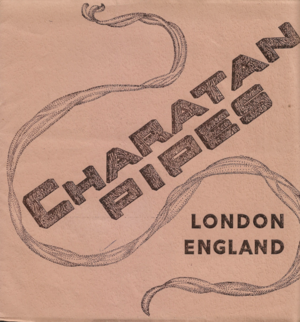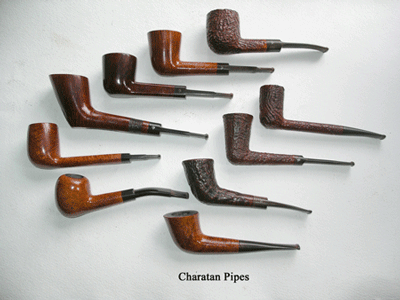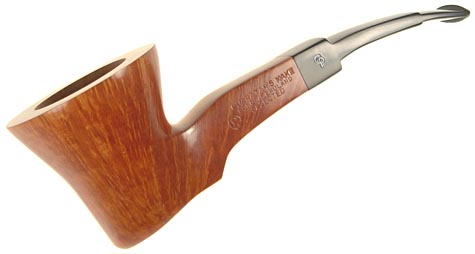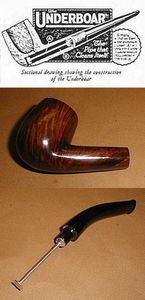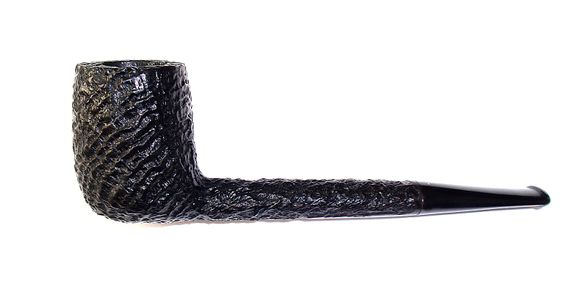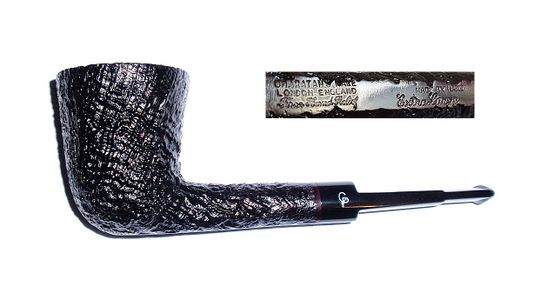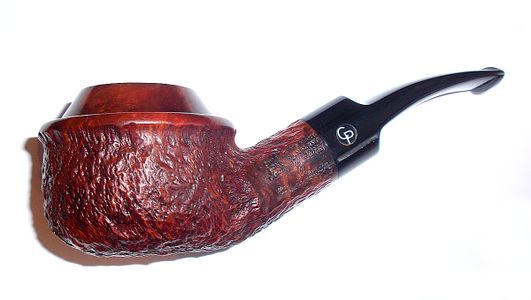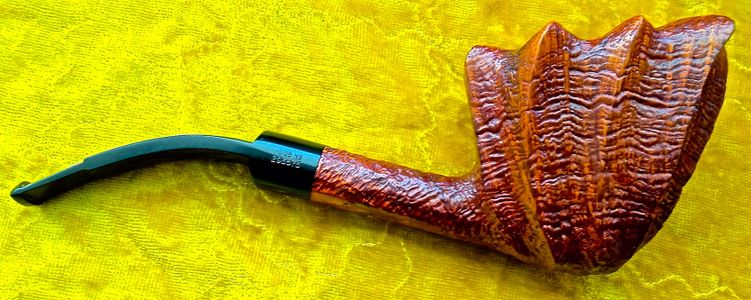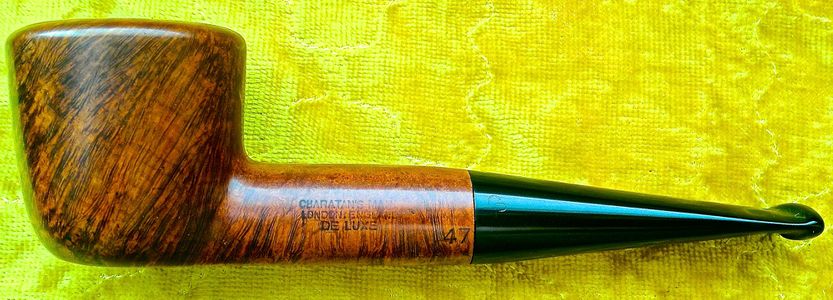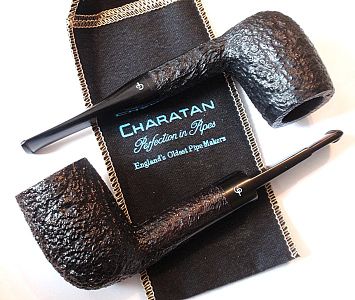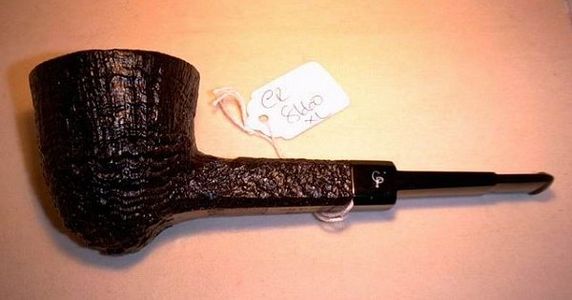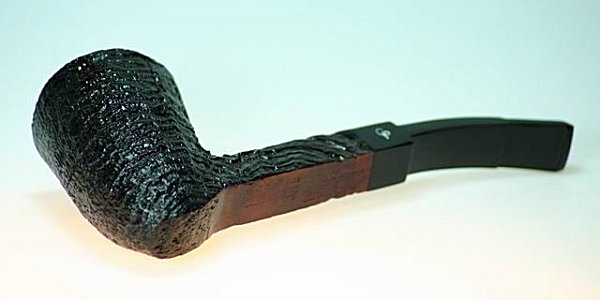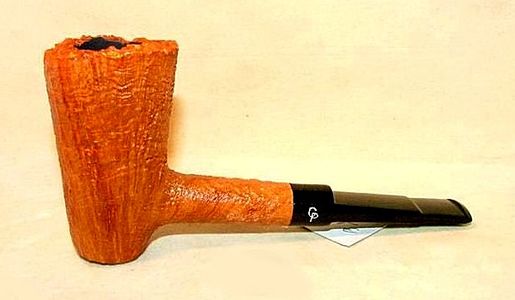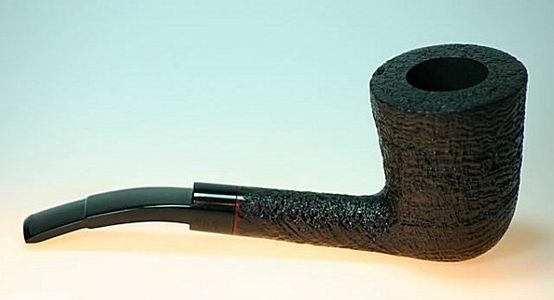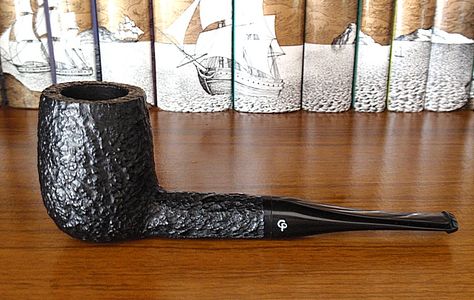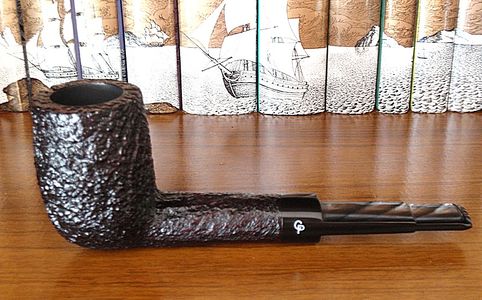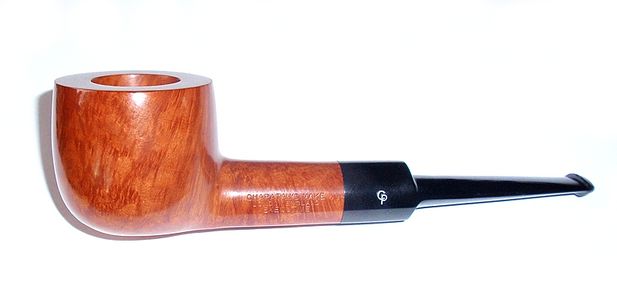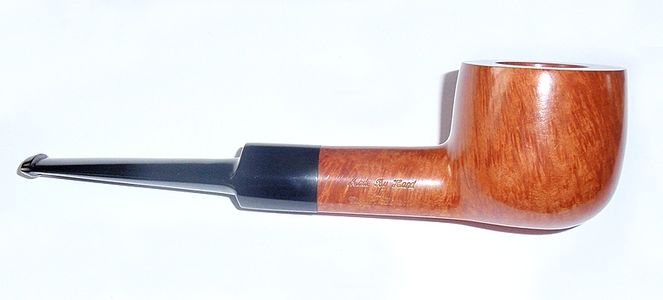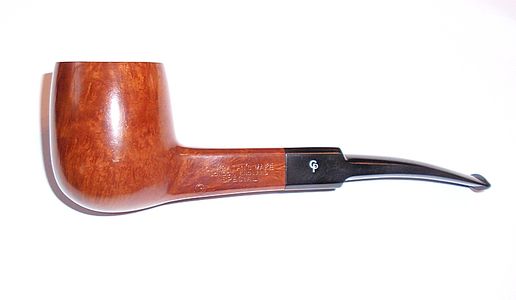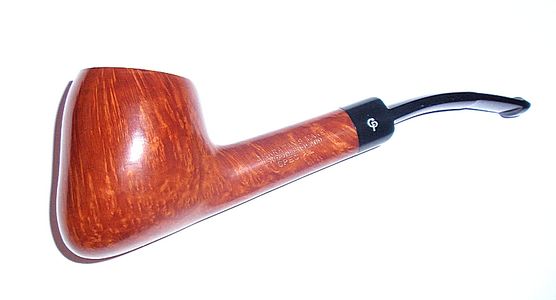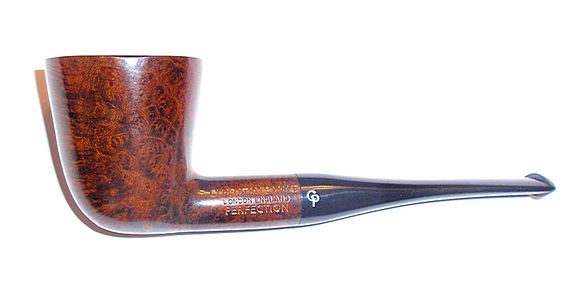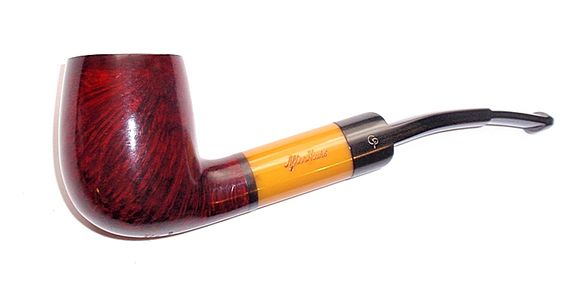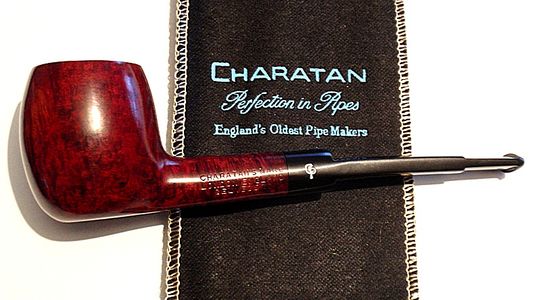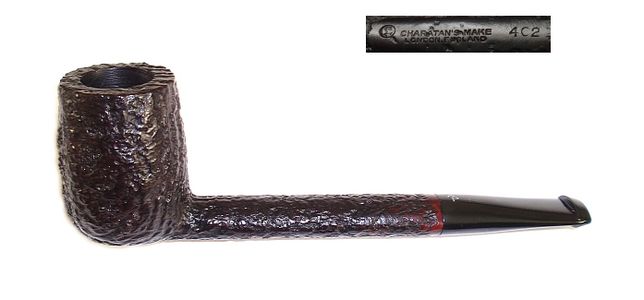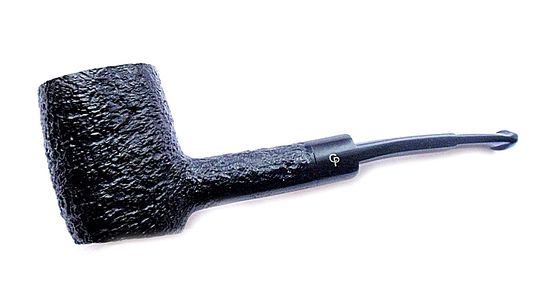|
|
| (73 intermediate revisions by 15 users not shown) |
| Line 1: |
Line 1: |
| [[Image:charatan1.jpg|thumb|300px|Early Lane period, courtesy [http://www.smokershaven.com/index.asp?PageAction=VIEWCATS&Category=681 SmokersHaven]]]''Charatan collectors, please consider contributing to this article''
| |
|
| |
| == Brief History == | | == Brief History == |
| Frederick Charatan created the brand in 1863 and opened a shop in Mansell Street London and later moved to Prescott Street. It was always a small family business with only a small annual production until the 1950's when Herman Lane assumed distribution of the make in the USA in 1955 and it became hugely popular. In the 1980's Lane sold the company to Dunhill and the Prescott Street factory closed in 1982 and thereafter the fame and quality of the make declined. The pre-Lane period prior to 1950 and the Lane era pipes are of primary interest the collector.
| |
|
| |
|
| [[Image:charatan.gif|thumb|left|400px|Charatans, courtesy of the [http://www.derek-green.com/Others.htm Derek Green Collection]] | | [[File:CharatanAd.jpg|thumb|Lane Era Charatan Ad, courtsy Doug Valitchka]] |
| Charatan "Smokers"
| | [[File:1951-Charatan-Catalog-Cover.png|thumb|[https://pipedia.org/images/3/37/CHARATAN_1951.pdf 1951 Charatan Catalog], Courtesy of user "alvagram"]] |
| From the top counter-clockwise
| |
| 1. Freehand Relief 4 with Lane stamp.
| |
| 2. Selected F.H. Lane stamp.
| |
| 3. Supreme "S" F.H. Lane stamp.
| |
| 4. Rarity Extra Large, Made by Hand.
| |
| Lane stamp.
| |
| 5. Special.30120 DC.Reg.No.203573
| |
| 6. Special. 317 DC
| |
| 7. Special. 61
| |
| 8. Nomenclature worn. Bought in London
| |
| in the 1960,s and travelled everywhere
| |
| with me in my motorcycle leathers!
| |
| 9. Freehand Relief.
| |
| 10.56 Lane stamp
| |
|
| |
|
| | In 1863 '''Frederick Charatan''', a Russian / Jewish immigrant, opened a shop in Mansell Street, located in the borough of Tower Hamlets, London E1, where he began to carve Meerschaum pipes. These pipes got very popular soon, and thus Charatan moved to a bigger workshop in Prescot Street, just around the corner. Here he began to make briar pipes which should make the name famous the world over. Charatan was the first brand to make entirely hand-made briars from the rough block to the finished pipe including the stems. The nomenclature "Charatan's make" refers to this method of production and was meant to differ Charatan from other brands who "assembled" pipes from pre-drilled bowls and delivered mouthpieces. |
|
| |
|
| | Being the undisputed No. 1 in English pipemaking, Charatan was approached by Alfred [[Dunhill]] who was unsatisfied with the quality of the pipes he imported from France. During 1908 - 1910 Dunhill bought pipes from Charatan paying exorbitant prices to ensure he had some of the very best pipes for sale in England. In 1910 he lured away Joel [[Sasieni]], one of Charatan's best carvers, and opened his own small pipe workshop on 28 Duke Street. |
|
| |
|
| | On the retirement of his father in 1910 '''Reuben Charatan''' took over the family business. |
|
| |
|
| | In 1950 '''Herman G. Lane''', striving to expand his business in Great Britain, made contacts with the Charatan family. Apparently Lane got a certain influence soon, but it was not until 1955 that Lane Ltd. became the sole distributor for Charatan’s in the United States superseding [[Wally Frank]]. This can be documented in a “biography” written for Herman G. Lane titled “Leaves from a Tobaccoman’s Log”. |
|
| |
|
| | Thanks to Herman G. Lane's dedicated labor Charatan became hugely popular in the States. As reported by Ken Barnes in an interview with Rick Newcombe, Reuben Charatan passed away in 1962, and his widow sold the firm to Herman Lane 1 or 2 years after his death.<ref>http://pipesmagazine.com/blog/pipe-manufacturer-retailer-spotlight/charatan-upshall-and-ken-barnes/</ref> In the early 1960s Charatan pipes were the first to overstep the $100 Dollar line in US pipe sales. In 1978 Lane's heirs sold the Charatan company to Dunhill. The Prescot Street factory was closed in March 1982. Thereafter the fame and quality of the make declined. |
|
| |
|
| | The pre-Lane period (prior to 1955) and the Lane era pipes (1955 to until sometime between 1979 - 1984) are of primary interest the collector. The Lane era is often quoted as beginning about 1950. |
|
| |
|
| | Charatan records are almost non-existent before Lane due to a factory fire, making it difficult to date pre-Lane pipes. Charatan used 4 basic grades prior to 1950: Supreme, Selected, Executive, and Belvedere. After 1950 Herman Lane's influence began, and the grades started to expand. In 1955 Lane took over sole distributorship of Charatan in the US. In 1957 he introduced the Supreme S. Most of his other introductions were from the 1960s and early 1970s. |
|
| |
|
| | === Charatan after Charatan - the more recent history === |
|
| |
|
| | In 1988 Dunhill sold the rights to the Charatan name, trademark and shape chart - there was hardly more left over to sell - to '''James B. Russell Inc.''' (Upper Saddle River, NJ). Russell had made his Charatan pipes in [[Saint-Claude]], France. [[Butz-Choquin]] is said to be the manufacturer. Now, Saint-Claude made pipes are surely not bad per axiom, but these Charatans were woefully poor counterfeits of the "real" ones and quite a flop in sale. |
|
| |
|
| | When J.B. Russell went out of business in 2002 Dunhill re-purchased Charatan and called on Colin Fromm of [[Invicta Briars]] and [[Castleford]] fame to produce Charatan freehands now. Since Colin Fromm and his foreman Colin Leeson, both belonging to the small number of English pipe artisans skilled in making high-end freehand shapes, had already been making exquisite freehands for Dunhill for a couple of years in Chatham, Kent. |
|
| |
|
| ----
| | To say the least, these Colin Fromm made Dunhill Charatans show impeccable craftsmanship and feature great smoking characteristics at very reasonable prices. |
| == Memories of Charatan Pipes and Notes on their Dating, By Ivy Ryan ==
| |
|
| |
|
| ''This article was originally published in 1998 in The Pipe Collector, the North American Society of Pipe Collectors newsletter ([http://www.naspc.org/ NASPC]), and is reprinted here by permission. It's a great group--consider joining.''
| | == Miscellaneous Notes == |
|
| |
|
| I joined the Women's Army Corps in 1963 and went through advanced training at Fort Monmouth from late 1963 to early 1964. I spent 20 years in the WAC and then the regular Army after the WAC was closed out. I had never smoked, though my parents did, and my father had smoked a pipe before I was born. What changed was that I was put into a barracks at Monmouth in which all the gals smoked. I have always found cigarettes to be irritating, but I decided to try fighting smoke with smoke. I went off-post to the Eatontown News and Smokes to check my options. A really nice old Italian man ran the place-named Luigi, I think-who was a bit confused by my mission. As far as he was concerned, women just didn't smoke cigars, and a pipe was out of the question. On the other hand, he was adaptable, and it was the early 60s: If I wanted to buy a pipe and learn to smoke it, that was my business. My first pipe was a GBD Collector Apple with fantastic birds-eye. Big for me, though I am a big woman, but it was SO beautiful.
| | [[File:char_41.jpg|thumb|From Charatan Flyer, ca. 1964]] |
|
| |
|
| My second pipe was a Dunhill-a group 3 Dublin Bruyere that I bought myself as a congratulation present for graduating my advanced training. Unfortunately, it burned through at Fort Dix. I was devastated. But I had to go through New York to get to my first overseas assignment in Turkey, so I figured I'd get it replaced in the Big Apple. Worked fine, except for the clerk insisting that my boyfriend shouldn't smoke so hard. Then the new pipe burned out on the flight to London! I was planning on a week's leave in London, so I decided to take the pipe to Dunhill's home office. This I did, only to be told, "Dunhill only replaces a pipe once." When I objected, the clerk told me, "You are obviously NOT the type of person who should smoke a Dunhill." That really made me feel good, as one can guess, so I left the pipe behind and stormed out.
| | === 1951 Charatan Catalog === |
|
| |
|
| Finding myself back to one pipe again, I decided to look in the phone book to see if any other pipe dealers were located near my hotel. I found a listing on nearby Prescott Street for a pipe called Charatan, so I dropped over because the place was still open. At this time, my only knowledge of pipe brands covered GBD and a lot of junk-including Dunhill. I had no idea of the history behind Charatan. I just wanted a pipe.
| | * We have just received a PDF copy of a [https://pipedia.org/images/3/37/CHARATAN_1951.pdf 1951 Charatan Catalog]. It is available here, courtesy of user "alvagram". |
|
| |
|
| I visited the shop, which turned out to be the factory, to see what they had. There I met a very nice, very British gentleman who, on hearing my story, took me inside to see the factory and find a pipe. I had told him about the fracas with Dunhill, and he agreed that that just wasn't a nice way to do business. In fact, he assured me that Charatan stood behind their pipes for the life of the owner. I got to see the whole shop, from the wood kilns to the turning, and I met a lot of the men who worked there, too. I was, and still am, almost overwhelmed by the beautiful pieces those men turned out. Their attitude was, "If it isn't perfect, then it's either a Belvedere, a rough, or firewood."
| | === Double Comfort === |
|
| |
|
| Anyway, I bought a Charatan that evening, and I still have it. It is, like my GBD, a bit big for me, but it never burned out. I did crack the shank once, but a silver band fixed that real well. I got into the habit of taking leaves in London after that, and I'd always stop in to get a new Charatan when I did. I also got into some gab sessions with the workers at the local pub after work. We would talk pipes, armies (most of the workers had served in WW II) and philosophies. They all believed in a good day's work to earn a good day's pay, and some of the older master carvers made very good money for the day, too. This was back when the US dollar was a big silver coin, and inflation was almost nil. But they all agreed that their reputation rode on the quality of their pipes. I really wish I could remember their names so that I could put names to the faces I do remember. I have never been that good at names, though, and, to be truthful, I wasn't doing research. I was enjoying myself and these craftsmen and their ideas.
| | Charatan records indicate the DC (Double Comfort) bit was introduced in the 1950s, but some report seeing them in earlier production. Still others indicate they were introduced by Lane in 1960. Regardless, the DC bit is not an accurate way to date a pipe because many Charatan’s were made with regular and saddle type bits throughout the “Lane Era”. |
|
| |
|
| One thing that I remember coming up from one of those sessions was the idea of tiers of pipe makers. This has nothing to do with the grade of the pipe but, rather, with the grade of the manufacturer. According to the Charatan carvers, the tiers went thusly.
| | === Nomenclature === |
|
| |
|
| Tier One, the top. This was a manufacturer all of whose pipes were completely made by hand (using tools such as grinders, files, drill presses and such), and the pipe was generally made, start to finish, by one man. No fills or pits were allowed, and the grain had to be excellent. At the time, only Charatan was Tier One. Now a lot of people fit there, from Bo Nordh to David Jones and Mark Tinsky.
| | The Lane Trademark serif and circled L indicates the pipe is from the “Lane Era” (approx. 1955 to 1979 -1984?), however it appears that both the English factory or Lane themselves sometimes, or perhaps even often forget to stamp the L on a pipe. The Charatan factory was known for inconsistencies, especially in stampings. Therefore, although an L on the pipe definitely defines it as a Lane Era pipe, the lack of it could simply mean the pipe missed receiving the stamp from the factory. The lack of the trademark could also mean the pipe was destined for the European market. |
|
| |
|
| Tier Two. Any manufacturer who hand made their pipes but in which the pipes were made by a team instead of a single expert making each pipe. Tier 2 pipes often have minor pits also but never any fills. Ser Jacopo, Don Carlos, Caminetto and most other Italian manufacturers are in this tier.
| | Charatan pipes were not well distributed prior to the Lane Era, so very few pre-Lane pipes exist today. Herman Lane greatly grew the brand in the U.S., which caused corresponding growth in Europe. |
|
| |
|
| Tier Three. A manufacturer who rough machined their own pipes, then hand finished them. These makers made their own stems, bands (if used) and the lot. The pipes were often made by more than one person. Pre-transition Barlings, early Comoys, and GBDs generally exemplified this tier. Grain didn't matter too much, though it was appreciated, but pits or fills were not allowed.
| | Generally, when the pipe is stamped with the BLOCK letters “MADE BY HAND” it means the pipe was probably made between 1958 and 1965” |
|
| |
|
| Tier Four. A maker who machined the stummel but made their own bit and did their own coloring. This tier of maker often bought bowls from other makers. No pits or fills were allowed, but grain wasn't even figured into the design. Dunhill exemplifies this tier. Dunhill also wasn't as picky about quality as they claim-after all, sandblasting covers all sins.
| | Generally, block letters “MADE BY HAND” and some of the other nomenclature in script (i.e. ''City of London'' or ''Extra Large'' next to the MADE BY HAND) means the pipe was made sometime between 1965 and the mid 1970s. The total script nomenclature “''Made by Hand in City of London''” evolved over this period of time, so many pipes had variants, such as Made By Hand in block letters and City of London in script, or some other variation of the terms or stampings. |
|
| |
|
| Tier Five and below. These we didn't care to talk about, as they weren't worth the pence they cost. These would have fills and pits and featured cheap and dirty construction-Kaywoodie, Medico, Dr. Grabow, Peterson and that lot. Now, lower tier makers could make a higher tier pipe, but it wasn't their forte. They were much happier doing what they did best. An example of a lower-tier company making a first-tier pipe is my husband's Peterson Gold Spigot: no fills, good wood, very good workmanship. Definitely a second-tier pipe from a fourth-tier company.
| | It is believed the FH was used on Charatan pipes between 1957 and 1967-68. Three different sizes were used. The Charatan Logo (CP) on the pipe bit was changed over the years. |
|
| |
|
| Charatan's Make has been my favorite brand ever since I bought that first pipe in April, 1964. Every time I was transferred to a new duty station from 1964 through 1973, I made sure to stop off in London and visit the Charatan shops and factory. I would wait until the guys really got going, then ask them questions about quality and such. I remember the oldest guy (I think he was called Auld Eddy) sitting there one time with his pint in one hand and his pipe in the other (the one he had made to graduate from apprenticeship, and you should have seen that pipe-indescribable and beautiful, for all that it had been smoked for 5 decades by then!) fulminating about "the cheap, crude lumber knock-offs" made by their competition. He could verbally dismantle any Dunhill, Comoy, Barling or any other maker's brand in a few pungent phrases. He especially disliked Dunhill's practice of buying bowls from other makers and selling them as Dunhill's make. He was nearly as upset by Dunhill's claims to buy only the "A and AA" grades when "We all know that all they want is certain shapes and sizes. They don't care about flaws because those are sandblasted out, so quality is nil indeed."
| | === Pronunciation === |
|
| |
|
| He once told of a time, back when he was an apprentice (c. 1910 or so) when he was "scutting" (cleaning and arranging stock) at "the old store" (Charatan's first store in London, I think) and found himself taken to the Palace to carry, load and unload for Mr. Charatan himself while Mr. Charatan showed the King a selection of pipes. (He said that the King took most of them because the problem of deciding which were the best was too difficult.) Anyway, his moral was that "I learned that if you made the very best of something, then the best would buy from you. So I decided to become the very best pipe carver that Charatan's Make had ever hired. I did it, too." He told us this about mid-1967, and he'd been there since around 1908 at that time, I'd guess.
| | In the United States, Charatan is often miss-pronounced. Rick Newcombe interviewed Ken Barnes and reports, "The pronunciation of Charatan pipes (not Sheraton) is likely to cause controversy, but the people who knew the Charatans say the matter is not open for debate. As Ken said, "Barry Jones would have gotten his ears boxed if he had called Reuben “Mr. Sheraton.”" |
|
| |
|
| Charatan's Make was started and first run in London in 1863 by Frederick Charatan, a Russian immigrant to London. His son Reuben took over the business when his father retired circa 1910, and Reuben's wife had to sell it when he died. They started out making their own briar pipes from ebuchauns or complete burls, and they continued doing just that for 97 years, until 1960, wholly owned by the Charatan family. Their boast was that Charatan's Make was the mark of the best pipes in the world. For some of us, this is a simple statement of fact. There was a saying in the 1960s that Dunhill, Comoy, Barling and the rest always tried to make perfect shapes and didn't worry about the looks of the grain, while Charatan went for perfect grain and didn't mind the shape as much. This saying was true. Charatan's pipe makers always went for the absolute best grain they could get from the briar at hand. Charatan did not make their pipes like anyone else at the time. Every other pipe company used various specialized pipe-making automatic machines to shape their pipes, so they got whatever the machine made. Charatan's Make pipes were hand made from the first and continued to be hand made as long as the Prescott Street factory was in service. Charatan had no way to do anything else, actually. They didn't have the required machines to make "machine-made" pipes until Ben Wade was purchased in 1965, and, as of 1973, they still hadn't put that type of machine in the Prescott Street factory. In the case of pipes with the CP, shape charts were an approximation, not a promise. Their master pipe makers were good enough to come very close to duplicating a previously made pipe, but never exactly. The only way to get a pipe made that way now is to buy from people like Mark Tinsky, David Jones, Bo Nordh or the few other masters who do it all by hand. The masters at Charatan's Make didn't even use lathes, drill presses, grinders or sanding wheels. Files and sandpaper sufficed for most of their work,
| | === Sub-brands/Seconds === |
|
| |
|
| Charatan did not cure their briar like any other pipe company either. Like the supreme wood workers of England's past, Charatan steamed the sap from the briar under pressure and then kiln dried the briar over an extended period of time. This gave them the least wastage of any technique. It also left their wood with completely open pores and no odd tastes from oil or sap left in the wood. The reason for this extra work on Charatan's part was not to hurry the curing of the briar but instead to rid the wood of all leftover sap and resins that otherwise would flavor the smoke. Most other companies simply air dry their burls (after they are boiled by the first processors, of course), so there is always some taste left from the sap and resins. In fact, Dunhill came up with their "oil curing" originally to get rid of those same saps and their noticeable taste. The oils that Dunhill used left their own taste, but it wasn't as objectionable as the sappy taste to some buyers.
| | * [[Mountbatten]] (apparently these are not seconds, but pipes made by Charatan apprentices) |
| | * London Straight Grain |
| | * International Selection |
| | * Falstaff |
| | * Samirva |
| | * Vauxhall |
| | * Britannia |
| | * Benlet |
|
| |
|
| In 1960, Charatan was sold to Lane Limited. Except for the introduction of the Double Comfort bit, Lane left the company alone, run by its original people, until about 1965. By the end of 1965, Lane had "made some changes," as noted below, which gave rise to the mythos of "pre-Lane" and "post-Lane" pipes. In 1978 or 1979, Dunhill bought Lane Limited, and that was the end for Charatan's Make as an independent firm. For just over a century, however, Charatan made the best pipes in the world.
| | === Supremes === |
|
| |
|
| By 1982, Dunhill had closed the Prescott Street factory, and all Charatans were actually Dunhills. Between 1978 or 1979 and 1982, Charatans were made at Prescott Street but were marked with the Dunhill-ordered D.C markings. They were the same quality as the older Charatans in most cases. I have a strong suspicion that Dunhill took some of the last Selected- and Supreme-grade pipes and put their own markings on them. This comes from having seen a Dunhill marked "Great Grain" with a distinctly Charatan shape. It's hard to miss the shapes that emerge when the grain is the important thing.
| | Supremes made before 1950 were mostly traditional shapes and smaller than after Lane started influencing Charatan. |
|
| |
|
| After 1988, the Charatan name became the property of the J. B. Russell company, and I have to admit that I know nothing at all about the J. B. Russell "Charatans." I have not seen any of the New Charatan middle to high grades to find out.
| | == Gallery == |
|
| |
|
| === Dating Charatans === | | <gallery widths="300" heights="200" mode="packed-hover"> |
| | charatan1.jpg|Early Lane period, courtesy [http://www.smokershaven.com/index.asp?PageAction=VIEWCATS&Category=681 SmokersHaven |
| | char_und5.jpg|Charatan '''Underbore'''; ca. 1930s |
| | CHARATAN’S MAKE LONDON.ENGLAND 20104.JPG|CHARATAN’S MAKE LONDON.ENGLAND 20104, courtesy of [http://blaik-pipes.ru/ Blaik-Pipes] |
| | Charatan Relief XL.jpg|CHARATAN MADE BY HAND REG. NO. 203573FREE HAND RELIEF XL, courtesy of [http://blaik-pipes.ru/ Blaik-Pipes] |
| | 0088-1.jpg|Charatan's Make Made by Hand in City of London, courtesy Yuriy Novikov |
| | CharatanFreehand.jpg|A Charatan Freehand sandblast from the period after Dunhill acquired the company, courtesy of Mike Ahmadi |
| | CharatanDeLuxe.jpg|A Rarely Encountered Pre-Lane Charatan De Luxe, courtesy of Mike Ahmadi |
| | B 1-3.jpg|Charatan 4420 & 4420DC, courtesy Yuriy Novikov |
| | Chara_n1.jpg| |
| | Chara_n2,.jpg| |
| | Chara_n3.jpg| |
| | Chara_n4.jpg| |
| | Charatan 1-1.jpg |
| | Charatan (2) 1-1.jpg |
| | 3115-1.jpg |
| | 3115-2.jpg |
| | 2477-1.jpg |
| | 3071-1.jpg |
| | 2201-1.jpg |
| | 2186-01-1.jpg |
| | F-1.jpg |
| | Charatan 402.jpg |
| | 0097-01.jpg |
| | </gallery> |
|
| |
|
| Charatans are difficult to date in that Charatan's guarantee was open ended. Unlike Dunhill, which dated its pipes so as to enforce its one-year guarantee, Charatan refused to worry about when a particular pipe was made. A Charatan pipe was replaced if it failed-no matter how old it was or how it had been treated-so there was no need to date the pipes. The way to date Charatan pipes is to be aware of the minor changes that were made during the years that Charatan was in business. With a bit of information as to the dates of some markings and stem changes, I introduce this approximate dating guide. A lot of these dates are going to be "about" or "approximately," and I am only able to cover the times from the mid 1950s to the sale by Dunhill to J.B. Russell circa 1988. My information is approximate because I do not have access to factory records. I am working from memory, stories I heard at the Prescott Street factory, and pipes I have owned over the years.
| | <div style="clear:both"> |
|
| |
|
| The keys for dating post-war to 1960-era Charatan pipes are the presence or absence of serifs (i.e., short lines stemming from and at an angle to the upper and lower ends of a letter) on the CP stamp, the presence or absence of the Lane "L" on tapered and early saddle bit stems, and the presence or absence of the renowned Double Comfort bit. After 1960, the dates may be determined by the stamping on the right side of the pipe. (Note: I was a 20-odd-year-old, pipe-smoking woman when I hung around Charatans. I was not a researcher, though I sure wish I had been. I have been told since that all pre-WW II records went up when the "old" factory was destroyed in the bombing, but I was just not interested. I really regret that now. I let a lot of history go, but all I can say is that I was younger then.)
| | [[Image:charatan.gif|thumb|left|400px|Charatans, courtesy of the [http://www.derek-green.com/Others.htm Derek Green Collection]]][[File:Mountbatten 812, courtesy of Chris Rigol.jpg|thumb|Mountbatten 812, courtesy of Chris Rigol]] |
| | | Charatan "Smokers" from the Derek Green Collection |
| The Lane Limited florid "L" is on almost all Charatans imported into the United States from somewhere after WW II until 1988. (Lane bought Charatan in 1960, but it began importing Charatan pipes in 1955, when it got the contract from Wally Frank, who had been importing them.) If the pipe in question has a tapered or saddle bit without the "L," then it is probably very old, possibly pre-war. Or it may not have been stamped. This did happen, and no one knows how often, but I think it was fairly infrequent.
| | From the top counter-clockwise |
| | | 1. Freehand Relief 4 with Lane stamp. |
| Pre-1955 Charatans-possibly back to the beginning-had pronounced serifs on the CP stamp and either a taper or saddle bit. Pipes made in 1955 or later had the same types of bits but without the serifs on the CP. The block letter "FH" marking, for "Free Hand," on either side of the stem was used from the 1940s or so until about 1958. The problem is that all pipes were not stamped "FH," even though all the pipes were actually hand made.
| | 2. Selected F.H. Lane stamp. |
| | | 3. Supreme "S" F.H. Lane stamp. |
| The block letter "MADE BY HAND" stamp on the right side or bottom of the shank came into use in early 1958 to replace the "FH" stamp and was used until late 1965. The letters were about one millimeter tall.
| | 4. Rarity Extra Large, Made by Hand. |
| | | Lane stamp. |
| The Double Comfort bit came into use in 1960 and is still in use. The Double Comfort bit looks like a fairly thick saddle bit, with another saddle cut into it about 3/4 of an inch from the button, which is the technical term for the raised and rounded end of a stem. The original design was supposed to produce a strong stem with a thin bite. It was also supposed to be a distinctive point about the brand, giving instant product recognition. The Double Comfort bit was probably the largest mistake that Charatan could have made. Bit shape and bite comfort ranged from excellent to terrible, with nothing to base a buyer's choice on but the width of the bit. The narrow versions were generally very comfortable, but the wide versions varied from thin enough to be comfortable to thick as a plank. This bit design probably led to the company's failure, because a person could no longer count on Charatan for a comfortable pipe to smoke. A consumer once bitten by a poor bit will be twice shy of buying another.
| | 5. Special.30120 DC.Reg.No.203573 |
| | | 6. Special. 317 DC |
| After 1960, Charatan didn't make any taper bits unless for special orders. They did make pipes with "normal" saddle bits. These pipes will have an "X"-with or without a line under or beside it-to indicate that the pipe in question was "supposed" to have a saddle bit and not a Double Comfort bit. I refer to this marking as the "X line" mark. That mark will look like this:
| | 7. Special. 61 |
| | | 8. Nomenclature worn. Bought in London |
| ####X (with the #### being some number, such as 4025).
| | in the 1960,s and travelled everywhere |
| | | with me in my motorcycle leathers! |
| In late 1965, the right-side stamping changed to a three-line set of stamps. The first and second lines read "MADE BY HAND" and "IN" respectively in block letters a bit larger (2 millimeters) than the earlier version. The third line reads "City of London" in script. This marking was only used for about six months and looked like this:
| | 9. Freehand Relief. |
| | | 10.56 Lane stamp |
| MADE BY HAND
| |
| | |
| IN
| |
| | |
| City of London
| |
| | |
| The next stamp used was the all-script, three-line "Made by Hand" "in" "City of London." This stamp was used from near the end of 1965 up until Dunhill took control of the company in 1979. It looked like this:
| |
| | |
| Made by Hand
| |
| | |
| In
| |
| | |
| City of London
| |
| | |
| After Dunhill bought Lane, thereby gaining control of Charatan, it kept the old Prescott Street factory open for a while, then merged all pipe production into its old Parker-Hardcastle plant. While the Prescott factory was open, it still made pipes, but these, to go along with the other pipes made for the Charatan name by the Parker-Hardcastle factory, were all marked with a number and "D.C." This stamp was supposed to be on the right side of the pipe. A pipe made at the Prescott Street factory will have the D.C and the number on any old way-unaligned, very light, uneven, or even on the left side or upside down. That "sloppiness" was intentional, I think. The workers at Charatan really didn't like the Dunhill mob and so weren't that cooperative, or so it seems to me at this remove in time. I have an example in my collection marked 2502 D.C. It is a size 2 (or so) that really does grade out as a Supreme. However, it was finished not long after the Dunhill takeover, so the other three numbers, 502 (imposed by the new Dunhill regime) are a bit off the line of the first two, and the "D.C." (another imposition) is off that line yet again, along with the stamping depths being different in each case. To make it more odd indeed, the pipe was graded "Special" instead of "Supreme." That probably cost Dunhill some serious money right there.
| |
| | |
| A "Charatan" made in the Parker-Hardcastle factory will have the number and the D.C neatly stamped. The pipes marked with the D.C from the old Charatan factory were made between 1978 or 1979 and 1982. Pipes made at the Parker-Hardcastle plant continued to use the D.C stamp until Dunhill sold the Charatan name in 1988.
| |
| | |
| The D.C has several meanings. On a Parker-Hardcastle-made pipe, it means "Fit with a Double Comfort bit," while on pipes made at Prescott, it has another meaning. That other meaning, which was told to me by a Dunhill executive, was "Dunhill's Charatan." The old rivalry was finished, and Dunhill had come out on top. Of course, Dunhill was a small part of a conglomerate by then, but...The marking looks like this: 2092 D.C
| |
| | |
| === Charatan grades ===
| |
| | |
| Charatan grades were simple until the crazy years of late 1965 to 1979. Up til then, they had, in order of increasing value:
| |
| | |
| The Rough These pipes had a rusticated shank and a sandblasted bowl finish dating from about 1930. This treatment was used to save the time and work in a pipe gone truly bad.
| |
| | |
| The Rarity These were pipes with otherwise good grain but some tiny flaws. These tiny flaws were carved over with pretty designs to save the work invested.
| |
| | |
| The Perfection These pipes were always cross-grained and were so named because Dunhills were most always cross-grained. Dunhill claimed to make "perfect pipes," so Charatan's Make were having their little joke. These were sometimes dyed walnut to bring out weak grain.
| |
| | |
| The Belvedere These had straightish but weak grain. This was Charatan's lowest class of smooth pipes. They were dyed plum color to bring out the grain.
| |
| | |
| Note: The "Perfections" were the lowest of the upper grades-smooth, dyed generally, and grained like a Dunhill Root, i.e., not much to speak of. The Perfection was the grade below Special and was basically mixed and weak grained. It seems to have been simply an insult to all the other pipe makers, especially to Dunhill. The rivalry was real, and as the first Mr. Charatan was an immigrant and a Jew, the rivalry got a bit vicious at times. The Belvederes were apprentice pipes, made to a simple numbered shape and, for Charatan, cheaply made. I rarely count them into Charatan's grades at all. They were, to Charatan, the equivalent of Dunhill's Bruyere grade, except that, for Charatan's Make, it was a practice grade for apprentices. The apprentice had a numbered form to copy, finish, make a bit for and then to stamp the form number on. Good ones would be graded and sold smooth, while ones with pits or small marks would be made into roughs."
| |
| | |
| The Special These were generally unstained or lightly stained. They had better grain, but it was not perfect by any means.
| |
| | |
| The Distinction Better grain than the Specials but not that good yet. These pipes were often given a light stain to bring out the grain.
| |
| | |
| The Executive Named for the executives in "The City" around the turn of the century, these unstained pipes had better grain than the Distinction. After 1965, some of this grade had a carved top to resemble plateau briar.
| |
| | |
| After Hours This unstained pipe was a grade when it first came out, with Selected-quality grain. The design of the After Hours allowed the use of smaller ebuchauns due to the horn (later plastic) section screwed to the truncated shank.
| |
| | |
| The Selected This grade had almost good enough grain to be the best, but not quite. These were not stained but were well finished, by which I mean, take the very best pipe by anyone else whose work you have ever seen. Imagine it even better. The pipe isn't stained but polished (inside and out) to a glassy, creamy briar-wood finish. Beautiful-though not perfect-grain and a hand-made stem with hand stamping and all. Not quite a Supreme but so close.
| |
|
| |
|
| The Supreme These pipes had the best straight grains they made at that time. These were always by comparison with other recently made pipes, so a Supreme may not be as good as an earlier Selected. These weren't stained either.
| | <div style="clear:both"> |
|
| |
|
| The difference between a Selected and a Supreme was usually decided by the master pipe makers on the work floor. The decision was sometimes a bit heated, but often everyone agreed from the last coarse sanding on. Woe was palpable when a bowl showed an irreparable flaw in the last sanding. I have seen a pipe get thrown across the work-room into the waste when a sudden flaw turned a Supreme into a Special. I still have the pipe, in fact, and I'll never forget the anguished curses.
| | == Charatan Brochure == |
| | <gallery mode="slideshow" caption="Charatan Brochure, courtesy Doug Valitchka"> |
| | File:Charatan-brochure1.jpg |
| | File:Charatan-brochure2.jpg |
| | File:Charatan-brochure3.jpg |
| | File:Charatan-brochure4.jpg |
| | </gallery> |
|
| |
|
| === Crazy Years === | | == Charatan Underboar catalog == |
| | * [https://pipedia.org/images/9/9a/Charatan-Underboar-catalogue-1920.pdf Circa 1920 Charatan Underboar catalog], courtesy Joseph Morris |
|
| |
|
| The start of the Crazy Years of late 1965 to the Dunhill buyout in 1979 saw the addition of the Coronation, Achievement, Crown Achievement, Royal Achievement and Summa Cum Laude high grades, the addition of the Freehand Relief, and the rearrangement of the lower grades. The new arrangement went Belvedere, Special, Freehand Relief and After Hours. The Perfection was dropped in this mix. The new "high-grades" were simply an attempt to cut the small Supreme pie into more-and more expensive-chunks.
| | == On Site Links == |
|
| |
|
| Sandblasted pipes stamped Charatan's Make over London England and a number are one version of the famous "Rough" grade. These were apprentice pipes that didn't come out well enough to be graded but were still eminently smokable. To save the wood and give the less-well-off a quality smoke, Charatan would first hand rusticate the pipe gently, then sandblast it. (Due to Dunhill's patent, they couldn't simply blast the pipe, and the rustication made for a very different blast.) Other Roughs will turn up with any of the other markings mentioned previously, but they were still roughed because the grain was pitted or severely marred. For example, I have an Extra Large Made by Hand that has a bad flaw up the side; otherwise, it is a great Oom Paul shape. So it was roughed and stemmed by an apprentice and sold much cheaper than it would have gone as a Special or higher grade. Roughs were the absolute bottom of the old (pre-Dunhill) Charatan line. They sold them simply to recoup some of the time and wood invested.
| | * [[Charatan - Milan 2014]]<br>Looking into who wrote this excellent article submitted to Pipedia by Doug Valitchka. This should eventually be compiled into the main article here. |
| | * [[Dating of Charatans]]<br>This excellent article has been translated for Pipedia by Mathias Acciai. The original article ([http://digilander.libero.it/tempioedonismo/CHARATAN.htm La datazione delle CHARATAN] in Italian) is a study by [[Fabio Ferrara]] of Monterubbiano - Italy. It is based on more than 2000 old Charatan pipes he studied from the "Basciano stock" purchased by Mario Lubinski - Fermo. This fantastic addition to the Charatan knowledge base is now in English here on Pipedia. |
| | * [[Charatan Models & Shape Information for the Collector]] |
| | * [[Memories of Charatan Pipes and Notes on their Dating]]<br>We have restored this article that appeared in ''The Pipe Collector''' written by Ivy Ryan, which had been removed from Pipedia. Charatan experts and enthusiasts indicate that this article contains miss-information as to the dating of Charatan pipes. Please keep this in mind if you decide to read it. --[[User:Sethile|sethile]] ([[User talk:Sethile|talk]]) 21:27, 21 November 2013 (UTC) |
| | * We have a PDF copy of a [https://pipedia.org/images/8/81/Charatan.pdf Charatan Catalog], courtesy Michael DiCuccio |
|
| |
|
| The following information on the "Authentic" Charatan and Charatan seconds is all my best guess. I had gotten out of Charatans before Lane sold out Charatan to Dunhill and thereby delivered Dunhill's only superior, and its real competition, into Dunhill's ungraceful hands. | | == Off Site Links == |
| | <revive zone="19" align="right" caption="An excellent selection of Estate pipes is available at The Danish Pipe Shop (A Pipedia Underwriter)" /> |
| | * [http://pipepages.com/charatan.htm Charatan related documents on Chris' Pipe Pages] |
| | * Wonderful circa 1945 newsreel footage from [http://www.britishpathe.com/record.php?id=48227 "Pipe Dream", British Pathe] |
| | * You may also enjoy listening to Brian Levine's interview of Ken Barnes on the [http://pipesmagazine.com/blog/radio-talk-show/the-pipes-magazine-radio-show-episode-178/ PipesMagazine Radio Show Part 1, February 9, 2016] and [http://pipesmagazine.com/blog/radio-talk-show/the-pipes-magazine-radio-show-episode-225/ Part 2, January 3rd, 2017]. Kennedy worked for Charatan starting at the age of 15, working for his father, who was managing director before the company was sold to [[Dunhill]], and he then moved on to start [[James Upshall]] with Barry Jones. |
|
| |
|
| At one time, smooth Charatan seconds were sold in the Columbus, OH, area and perhaps elsewhere. In the old days, Charatan didn't have smooth seconds to sell. If a pipe wasn't good enough for a grade (Belvedere or better) it was rusticated and sandblasted and sold as a "Rough." These Charatan seconds are smooth and machine made, neither of which Charatan did. I think this can be explained by keeping a couple of facts in mind. When Ben Wade went out of business in 1965, Charatan bought what was left. At this time, Charatan acquired the machinery necessary to machine make pipes. Charatan didn't use this machinery, but when Dunhill acquired the Charatan firm, they also got the ancient machinery. Not being a company to miss a profit and a chance to "stick one in Charatan's historical eye," the Dunhill company turned out a huge number of third-rate pipes (even for them) and sold them as Charatan seconds.
| | <blockquote><q>I need to point out that there seems to be some confusion around my father's position at Charatans and mine. My father, Kenneth Barnes, was the Managing Director of Charatan Pipes during the 1970s and I (Kennedy Barnes) was learning the trade at Charatans during this time and then formed the Tilshead Pipe Co. Ltd. ([[James Upshall]]) with Barry Jones in 1978.</q></blockquote> |
|
| |
|
| I have also been asked about the "Authentic" marked Charatans. They are obviously of Perfection grade, and, from the markings of the ones I have seen, they were turned out after Dunhill bought Lane and thereby acquired Charatan. Keep that in mind and remember the reason for the Perfection grading by the old Charatan firm-that is, Charatan's Perfection was their lowest smooth grade, and yet the pipes had as good a grain as the Dunhill Root Briar grade. Dunhill always "claimed" that their pipes were perfect, so Charatan made a bit of a quality statement there. Of course, after Dunhill bought Charatan, they dropped the Perfection grade and had to replace it with something.
| | == References == |
| | <references /> |
|
| |
|
| ''This article was originally published in 1998 in The Pipe Collector, the North American Society of Pipe Collectors newsletter ([http://www.naspc.org/ NASPC]), and is reprinted here by permission. It's a great group--consider joining.''
| | [[Category: Pipe makers by nationality]] |
| | [[Category: Great Britain]] |
| | [[Category:Charatan]] |
Brief History
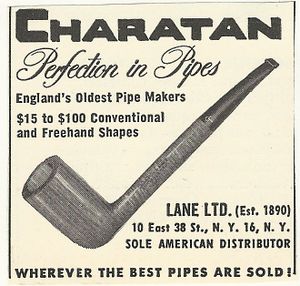
Lane Era Charatan Ad, courtsy Doug Valitchka
In 1863 Frederick Charatan, a Russian / Jewish immigrant, opened a shop in Mansell Street, located in the borough of Tower Hamlets, London E1, where he began to carve Meerschaum pipes. These pipes got very popular soon, and thus Charatan moved to a bigger workshop in Prescot Street, just around the corner. Here he began to make briar pipes which should make the name famous the world over. Charatan was the first brand to make entirely hand-made briars from the rough block to the finished pipe including the stems. The nomenclature "Charatan's make" refers to this method of production and was meant to differ Charatan from other brands who "assembled" pipes from pre-drilled bowls and delivered mouthpieces.
Being the undisputed No. 1 in English pipemaking, Charatan was approached by Alfred Dunhill who was unsatisfied with the quality of the pipes he imported from France. During 1908 - 1910 Dunhill bought pipes from Charatan paying exorbitant prices to ensure he had some of the very best pipes for sale in England. In 1910 he lured away Joel Sasieni, one of Charatan's best carvers, and opened his own small pipe workshop on 28 Duke Street.
On the retirement of his father in 1910 Reuben Charatan took over the family business.
In 1950 Herman G. Lane, striving to expand his business in Great Britain, made contacts with the Charatan family. Apparently Lane got a certain influence soon, but it was not until 1955 that Lane Ltd. became the sole distributor for Charatan’s in the United States superseding Wally Frank. This can be documented in a “biography” written for Herman G. Lane titled “Leaves from a Tobaccoman’s Log”.
Thanks to Herman G. Lane's dedicated labor Charatan became hugely popular in the States. As reported by Ken Barnes in an interview with Rick Newcombe, Reuben Charatan passed away in 1962, and his widow sold the firm to Herman Lane 1 or 2 years after his death.[1] In the early 1960s Charatan pipes were the first to overstep the $100 Dollar line in US pipe sales. In 1978 Lane's heirs sold the Charatan company to Dunhill. The Prescot Street factory was closed in March 1982. Thereafter the fame and quality of the make declined.
The pre-Lane period (prior to 1955) and the Lane era pipes (1955 to until sometime between 1979 - 1984) are of primary interest the collector. The Lane era is often quoted as beginning about 1950.
Charatan records are almost non-existent before Lane due to a factory fire, making it difficult to date pre-Lane pipes. Charatan used 4 basic grades prior to 1950: Supreme, Selected, Executive, and Belvedere. After 1950 Herman Lane's influence began, and the grades started to expand. In 1955 Lane took over sole distributorship of Charatan in the US. In 1957 he introduced the Supreme S. Most of his other introductions were from the 1960s and early 1970s.
Charatan after Charatan - the more recent history
In 1988 Dunhill sold the rights to the Charatan name, trademark and shape chart - there was hardly more left over to sell - to James B. Russell Inc. (Upper Saddle River, NJ). Russell had made his Charatan pipes in Saint-Claude, France. Butz-Choquin is said to be the manufacturer. Now, Saint-Claude made pipes are surely not bad per axiom, but these Charatans were woefully poor counterfeits of the "real" ones and quite a flop in sale.
When J.B. Russell went out of business in 2002 Dunhill re-purchased Charatan and called on Colin Fromm of Invicta Briars and Castleford fame to produce Charatan freehands now. Since Colin Fromm and his foreman Colin Leeson, both belonging to the small number of English pipe artisans skilled in making high-end freehand shapes, had already been making exquisite freehands for Dunhill for a couple of years in Chatham, Kent.
To say the least, these Colin Fromm made Dunhill Charatans show impeccable craftsmanship and feature great smoking characteristics at very reasonable prices.
Miscellaneous Notes
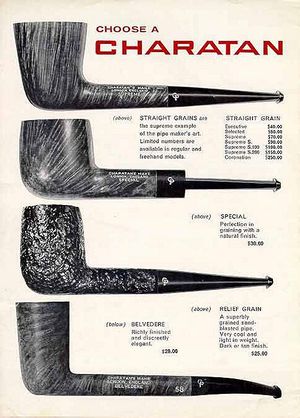
From Charatan Flyer, ca. 1964
1951 Charatan Catalog
- We have just received a PDF copy of a 1951 Charatan Catalog. It is available here, courtesy of user "alvagram".
Double Comfort
Charatan records indicate the DC (Double Comfort) bit was introduced in the 1950s, but some report seeing them in earlier production. Still others indicate they were introduced by Lane in 1960. Regardless, the DC bit is not an accurate way to date a pipe because many Charatan’s were made with regular and saddle type bits throughout the “Lane Era”.
Nomenclature
The Lane Trademark serif and circled L indicates the pipe is from the “Lane Era” (approx. 1955 to 1979 -1984?), however it appears that both the English factory or Lane themselves sometimes, or perhaps even often forget to stamp the L on a pipe. The Charatan factory was known for inconsistencies, especially in stampings. Therefore, although an L on the pipe definitely defines it as a Lane Era pipe, the lack of it could simply mean the pipe missed receiving the stamp from the factory. The lack of the trademark could also mean the pipe was destined for the European market.
Charatan pipes were not well distributed prior to the Lane Era, so very few pre-Lane pipes exist today. Herman Lane greatly grew the brand in the U.S., which caused corresponding growth in Europe.
Generally, when the pipe is stamped with the BLOCK letters “MADE BY HAND” it means the pipe was probably made between 1958 and 1965”
Generally, block letters “MADE BY HAND” and some of the other nomenclature in script (i.e. City of London or Extra Large next to the MADE BY HAND) means the pipe was made sometime between 1965 and the mid 1970s. The total script nomenclature “Made by Hand in City of London” evolved over this period of time, so many pipes had variants, such as Made By Hand in block letters and City of London in script, or some other variation of the terms or stampings.
It is believed the FH was used on Charatan pipes between 1957 and 1967-68. Three different sizes were used. The Charatan Logo (CP) on the pipe bit was changed over the years.
Pronunciation
In the United States, Charatan is often miss-pronounced. Rick Newcombe interviewed Ken Barnes and reports, "The pronunciation of Charatan pipes (not Sheraton) is likely to cause controversy, but the people who knew the Charatans say the matter is not open for debate. As Ken said, "Barry Jones would have gotten his ears boxed if he had called Reuben “Mr. Sheraton.”"
Sub-brands/Seconds
- Mountbatten (apparently these are not seconds, but pipes made by Charatan apprentices)
- London Straight Grain
- International Selection
- Falstaff
- Samirva
- Vauxhall
- Britannia
- Benlet
Supremes
Supremes made before 1950 were mostly traditional shapes and smaller than after Lane started influencing Charatan.
Gallery
Charatan Underbore; ca. 1930s
CHARATAN’S MAKE LONDON.ENGLAND 20104, courtesy of Blaik-Pipes
CHARATAN MADE BY HAND REG. NO. 203573FREE HAND RELIEF XL, courtesy of Blaik-Pipes
Charatan's Make Made by Hand in City of London, courtesy Yuriy Novikov
A Charatan Freehand sandblast from the period after Dunhill acquired the company, courtesy of Mike Ahmadi
A Rarely Encountered Pre-Lane Charatan De Luxe, courtesy of Mike Ahmadi
Charatan 4420 & 4420DC, courtesy Yuriy Novikov
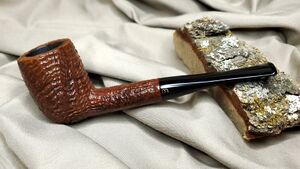
Mountbatten 812, courtesy of Chris Rigol
Charatan "Smokers" from the Derek Green Collection
From the top counter-clockwise
1. Freehand Relief 4 with Lane stamp.
2. Selected F.H. Lane stamp.
3. Supreme "S" F.H. Lane stamp.
4. Rarity Extra Large, Made by Hand.
Lane stamp.
5. Special.30120 DC.Reg.No.203573
6. Special. 317 DC
7. Special. 61
8. Nomenclature worn. Bought in London
in the 1960,s and travelled everywhere
with me in my motorcycle leathers!
9. Freehand Relief.
10.56 Lane stamp
Charatan Brochure
- Charatan Brochure, courtesy Doug Valitchka
Charatan Underboar catalog
On Site Links
- Charatan - Milan 2014
Looking into who wrote this excellent article submitted to Pipedia by Doug Valitchka. This should eventually be compiled into the main article here.
- Dating of Charatans
This excellent article has been translated for Pipedia by Mathias Acciai. The original article (La datazione delle CHARATAN in Italian) is a study by Fabio Ferrara of Monterubbiano - Italy. It is based on more than 2000 old Charatan pipes he studied from the "Basciano stock" purchased by Mario Lubinski - Fermo. This fantastic addition to the Charatan knowledge base is now in English here on Pipedia.
- Charatan Models & Shape Information for the Collector
- Memories of Charatan Pipes and Notes on their Dating
We have restored this article that appeared in The Pipe Collector' written by Ivy Ryan, which had been removed from Pipedia. Charatan experts and enthusiasts indicate that this article contains miss-information as to the dating of Charatan pipes. Please keep this in mind if you decide to read it. --sethile (talk) 21:27, 21 November 2013 (UTC)
- We have a PDF copy of a Charatan Catalog, courtesy Michael DiCuccio
Off Site Links
An excellent selection of Estate pipes is available at The Danish Pipe Shop (A Pipedia Underwriter)
I need to point out that there seems to be some confusion around my father's position at Charatans and mine. My father, Kenneth Barnes, was the Managing Director of Charatan Pipes during the 1970s and I (Kennedy Barnes) was learning the trade at Charatans during this time and then formed the Tilshead Pipe Co. Ltd. (James Upshall) with Barry Jones in 1978.
References
